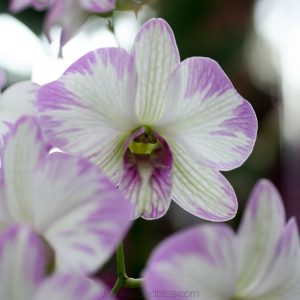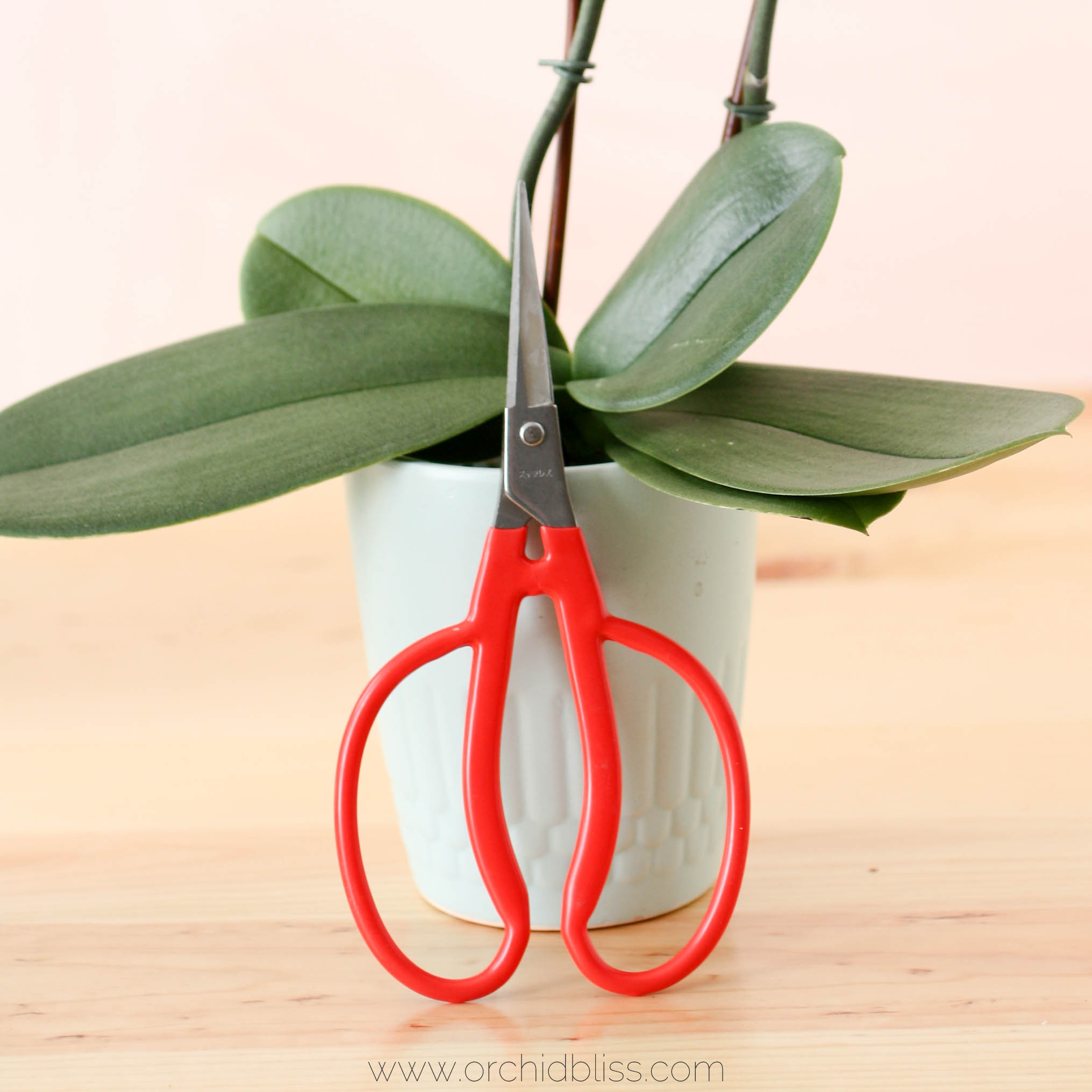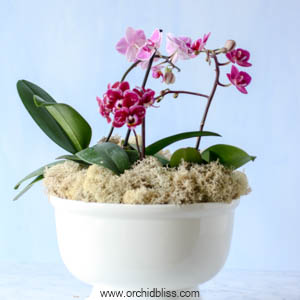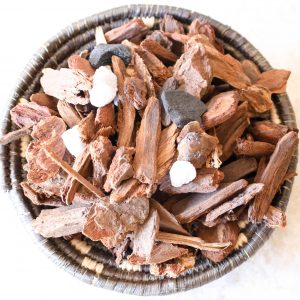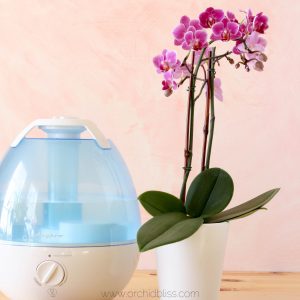
It’s no secret that orchids need humidity, but finding the right balance for you and your orchids can be tricky. But, it doesn’t have to be.
Discover why orchids need humidity, plus, 4 steps on how to do it.
- grow orchids that suit humidity levels your home can reasonably provide (see varieties below),
- learn different methods to supply humidity, such as a tray or humidifier,
- track humidity levels with a humidistat,
- provide airflow with a fan.
Bonus: At the end of this article, I’ve added an update about an experiment that increases humidity for my orchids without damaging my home.
It’s that easy!
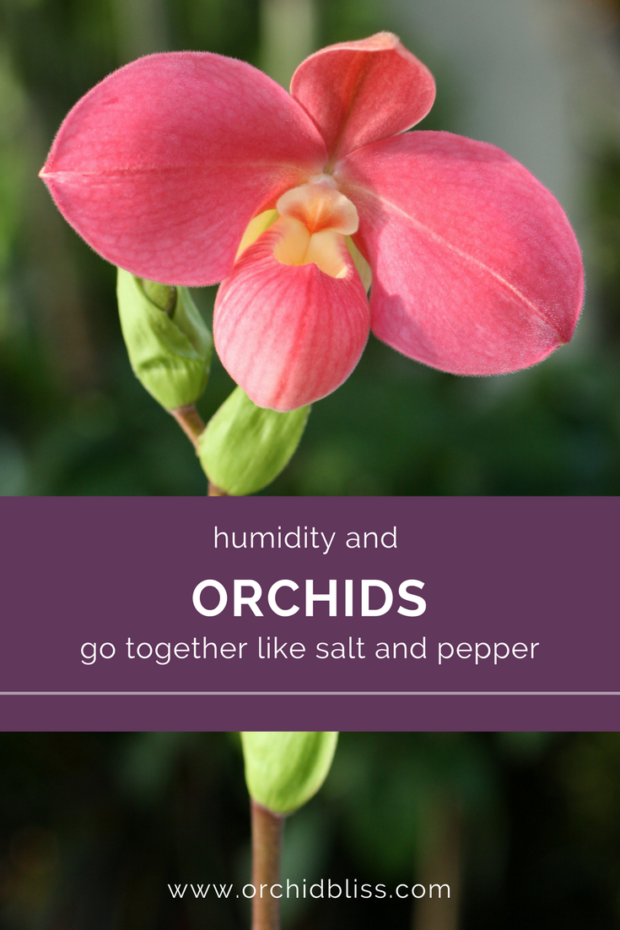
Some of the links on this page may be affiliate links. Click here to learn more.
Humidity and Why Orchids Need It
Humidity is the percentage of water vapor in the air. You’ve likely observed that humidity is lowest during the day and highest in the evening, night, and morning.
Here’s why orchids require humidity. It’s all about breathing. Imagine you are outside on a cold day. What happens when you exhale? You can see your breath or water condensation. When we breathe we lose water. It’s just more visible when we’re outside in the cold. As another example, when your glasses are dirty, breathing on the lenses adds enough moisture that it’s easy to give them a quick polish with a clean cloth. Orchids also lose water when they breathe.
Orchids and all plants have stomata or pores on leaves that allow the orchid to breathe-absorb carbon dioxide and repel oxygen. When orchids open their stomata to breathe they lose water. Humidity compensates for the water lost when opening their stomata.
When orchids don’t get enough humidity a drought situation ensues. If humidity levels are too low this means that the water loss through the stomata is greater than the water absorbed through the roots. In response to low humidity levels, the orchid closes its stomata and stops absorbing carbon dioxide. In essence, if humidity levels are too low, the orchid stops breathing.
Orchids in the Wild
When caring for orchids it is helpful to think of them growing in their natural environment. The vast majority of cultivated orchids originate from tropical climates and cloud forests with high humidity and constant air movement.
The challenge for those of us who grow orchids in our homes is that most orchids require a minimum of 45-50% humidity – the maximum humidity levels home growers should aim for in order to protect the drywall in our homes. Providing airflow is a much simpler matter – a small fan will do nicely.
How to Know If Humidity Levels Are Too Low, Or Too High For Your Orchid
Desiccation, or leaf drop, is an indication of both too much and too little humidity. If your orchid’s leaves are dropping look for other symptoms. If roots are rotting, humidity may be too high. Or, if the pseudobulbs are wrinkly and shrunken, humidity may be too low.
Depending on the orchid type, another reason for desiccation may be dormancy. For orchids that go through a dormant period in winter, the orchid’s leaves will turn yellow and fall off. If the orchid is deciduous, it’s completely normal for the orchid to lose its leaves. If, on the other hand, the orchid is evergreen, the leaves should not drop.
1- Grow Orchids with Humidity Requirements You Can Meet
Although many orchids prefer humidity levels between 50-80 percent, the recommended humidity for our homes is between 30 to 50 percent. Find the sweet spot where you can live peaceably with your orchid and without destroying your drywall. If you grow your orchids in-house like I do, grow orchids that thrive with lower humidity levels.
Even so-called low humidity orchids need humidity levels around 40%. I’ll admit that sometimes in the winter even that much is a struggle and I’m happy to get 30%. Here are a few examples of orchids that thrive with humidity levels between 40-50%:
- Cattleya
- Oncidium
- Paphiopedilum
- Phalaenopsis
- Laelia – rupicolous group
If your humidity levels are particularly low, between 35-40%, try growing these varieties:
- Australian type Dendrobiums, such as the popular Dendrobium kingianum.
- Catasetum
- Laelia – purpurata group
TIP: Many people wonder about providing humidity for Phalaenopsis orchids. It’s nice to know that these orchids are considered low humidity orchids. Although these orchids do best with humidity levels between 40-50% they will tolerate lower humidity levels.
2- Ways to Increase Humidity
In the winter months, especially when the furnace is running, air can be especially dry. Chapped lips, split fingertips, and static electricity all indicate dry air. Or, if you’re like me and live in an arid climate, you may need to increase the humidity level in your home year-round. That said, it’s important not to over humidify. Remember, you cannot compensate for a lack of humidity in the air by increasing water to the roots. Orchids require water vapor in the air. It’s a law of nature.
Orchid Humidity Tray
One popular way to increase humidity is to use a humidity tray for orchids. Simply fill the tray with gravel then pour water into the tray until it is about halfway full. This will ensure that the orchid pot will sit on top of the gravel and not in the water. If an orchid’s roots sit in water they will rot and die. In this way, water evaporating around the orchid provides a microclimate of humidified air.
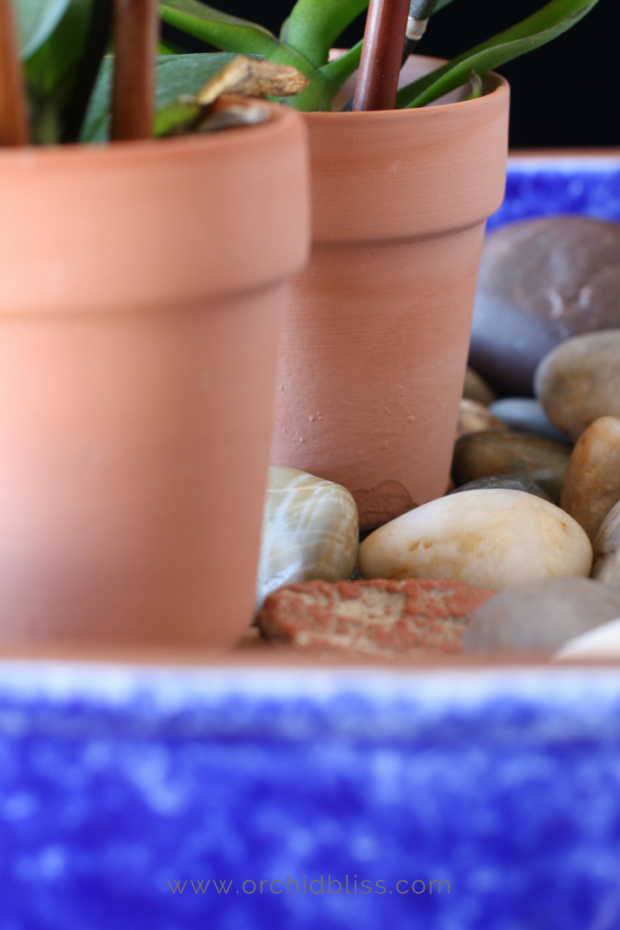
Because I live in a high desert, I use a humidifier.
Use a Humidifier for Orchids
I use a humidifier for my orchids, and it works. You can purchase a humidifier at any local home goods store or order one online. When using a humidifier, follow the manufacturer’s instructions to ensure that undue moisture does not accumulate. Check windows and mirrors for condensation–those are signs of too much humidity. We don’t want to encourage mold!
Buy a humidifier with the largest water tank that you can afford. This will reduce the number of times that you will have to refill the tank.
To reduce fungal and bacterial growth keep your humidifier clean. Follow the manufacturers’ instructions and clean your humidifier. It’s that simple, and, admittedly, it’s a pain too. But regularly cleaning your humidifier will reduce the amount of fungus and bacteria in the air.
Misting to Increase Humidity Around Orchids
Using a hand mister on your orchids is a temporary fix and will not raise the humidity around the orchids. In fact, misting the orchid’s leaves can lead to infection – especially when the air is stagnant and there is no airflow.
This does not mean that you should never mist orchids. Misting orchid roots, particularly mounted orchids, benefit from regularly misting their roots – not their leaves.
Using a Hose and Misters to Elevate Humidity
It’s a snap to increase humidity outdoors and in a greenhouse as you don’t have to worry about ruining your drywall. Outdoor growers can increase humidity by turning on misters. If you use a greenhouse to grow orchids, just spray down the floor for higher humidity.
3- Track Humidity Levels with a Humidistat
I am a big proponent of using a humidity gauge called a humidistat. This little guy will help you to make necessary adjustments so you don’t get too little, or too much humidity. The humidistat that I use tells me the humidity high and low and also the temperature high and low over the past 12 hours. I check my humidistat regularly. Observe seasonal humidity changes and then make necessary adjustments.
4- Add Air Movement to Reduce Airborne Infection
A fan is every serious orchid grower’s friend. Airflow is the counterbalance to humidity. Orchids need humidity to breathe and, just as importantly, orchids need good air movement to stay healthy. Disease, mold, fungus, bacteria all have a harder time taking hold of your orchid with steady, yet gentle airflow.
Together humidity and air movement are a perfect combination. One without the other creates problems. Humidity without airflow creates the perfect environment for disease. Airflow without humidity results in dehydrated orchids. Working together humidity and airflow combine to create a healthy orchid climate.
Why Orchids Benefit From Air Movement
- Air circulation helps reduce bacterial disease on your orchids and mold spores in your house.
- On warm days, air movement helps moderate temperatures – cooling and drying leaves and new growths.
- Good airflow helps ensure that the orchids get proper amounts of carbon dioxide and oxygen necessary for photosynthesis (the process plants use to turn sunlight into energy) and transpiration (the way plants breathe – absorb carbon dioxide and emit oxygen).
- Air exchange flushes out air pollutants, such as ethylene, that can cause tender buds to wither and drop, which results in extreme sadness for the orchid grower.
How to Use a Fan to Add Air Movement Around Orchids
Most any type of fan will work, including:
- Ceiling fan
- Oscillating fan
- Computer fan
- A small, household fan
Simply turn the fan to the lowest setting and face the fan away from the orchids. Pointing the fan directing at the orchids can be too drying. If you’re committed to growing healthy orchids and preventing fungal and bacterial growth, use a fan.
Other Ways to Increase Air Flow for Orchids
First off, weather permitting, you can always crack a window. Secondly, while grouping plants together increases humidity around the plants, take care not to overcrowd the plants and to give enough space that air can move freely around the plants.
Using Humidity to Heal an Orchid with Root Loss
If an orchid has been overwatered, or if fertilizer salts have built up in the potting medium, the roots can quickly deteriorate and die. If your orchid has experienced root loss, all is not lost.
- First, wrap what’s left of the roots in damp sphagnum moss.
- Next, create an open humidity tent – picture a mini greenhouse – by placing the orchid in an open, clear, plastic bag, or in a container without a lid.
- Finally, place the orchid, tent and all, in a shaded spot where it won’t get too warm or dried out.
- Keep an eye on the “mini-greenhouse” to be sure that water does condense on the sides of the plastic bag or container. Likewise, watch to see that the sphagnum moss does not dry out.
- When the orchid is healthy and new roots have emerged, it may join the rest of your orchid collection.
Bless Your Life – Grow Orchids
I am a firm believer that bringing nature into our homes improves the quality of our lives, often in unexpected ways. Before growing orchids, the air in my house, especially during the winter months, was so dry my fingers would crack and bleed. If your fingertips have split due to dry air, you know that they take FOREVER to heal. Now that I’m using a humidifier for my orchids, my fingers are reaping the benefits.
To successfully grow orchids in your home, I have just 4 recommendations:
- Grow orchids that tolerate humidity between 40-50%. This list includes Cattleya, Oncidium, Phalaenopsis, Paphiopedilum, Australian type Dendrobiums like Den. kingianum, Catasetum, and Laelia orchids. That’s a pretty good list!
- If you need to increase humidity levels for your orchids, use a humidity tray, or invest in a humidifier.
- Buy a humidistat. Make it easy on yourself and your orchids and take the guesswork out of your humidity levels. (Note: This is something you can’t Google because outdoor humidity levels differ from indoor humidity levels. Like Google, humidity apps for your phone take their readings from weather stations using your GPS coordinates – not your home.)
- Use a fan. Orchids need air movement to prevent fungal and bacterial growth on their leaves that accompany the humidity that they love.
My Indoor Cold Frame Experiment
My biggest struggle as a windowsill orchid grower living in the desert is lack of humidity. As an indoor grower, I don’t let my humidity get over 50%. I wondered what I could do to grow orchids indoors, and be able to safely increase the humidity. That’s when I thought of bringing in the cold frame sitting outside in the garden.
First, I scrubbed down the cold frame. Lots of dirt had accumulated on the fiberglass walls that would block light to the orchids.
Initially, I hoped that the orchids placed together in a small space, the cold frame, would boost humidity levels so that I wouldn’t have to use a humidifier.
Next, while the humidity did increase without a humidifier, I knew I could safely add more humidity inside the cold frame without damaging my house, so I added a humidifier, humidistat, and a fan.
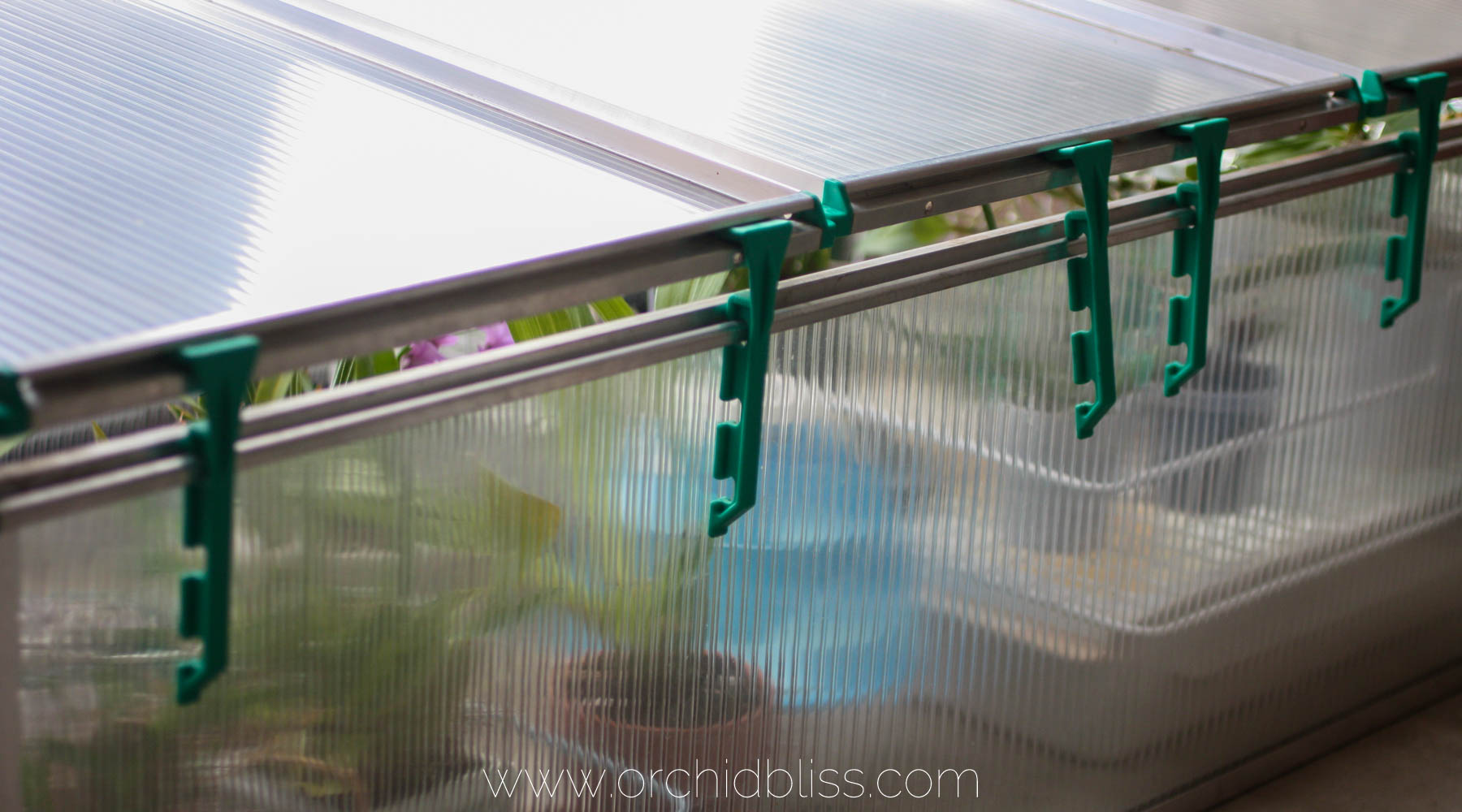
Remember: where there is humidity, there must be air movement. Air movement goes a long way in preventing bacterial and fungal problems.
Keep Learning
To help you further, start by downloading my free cheat sheet to see where to cut the orchid flower spike after blooms have faded to trigger re-blooming. Click here, for the cheat sheet. It’ll be super helpful.


